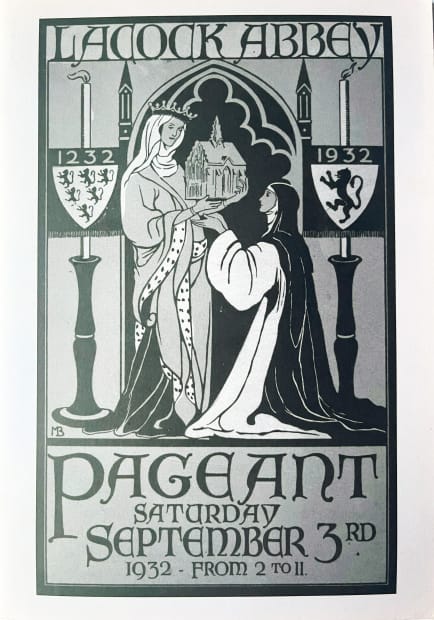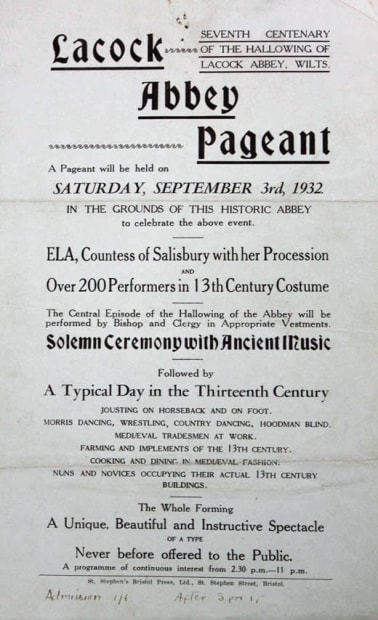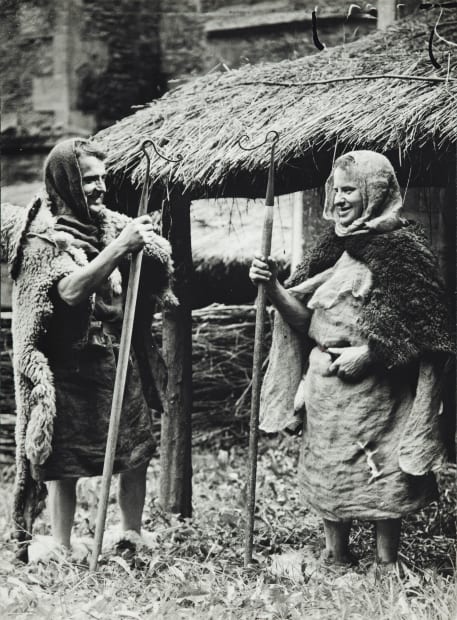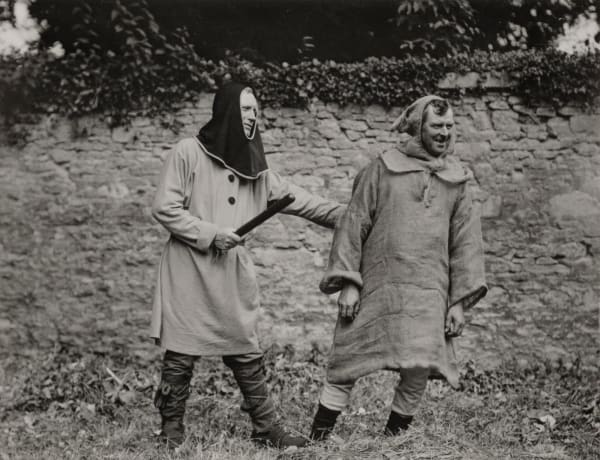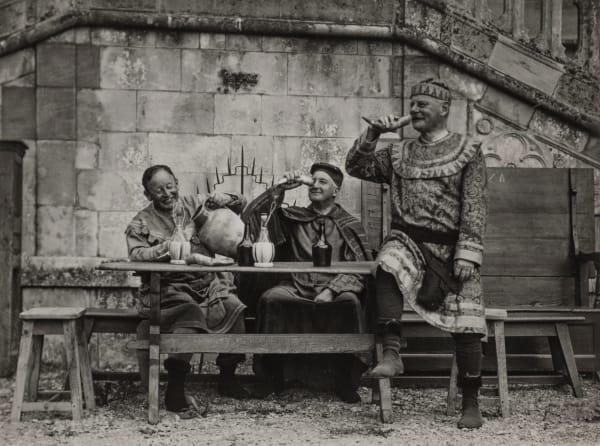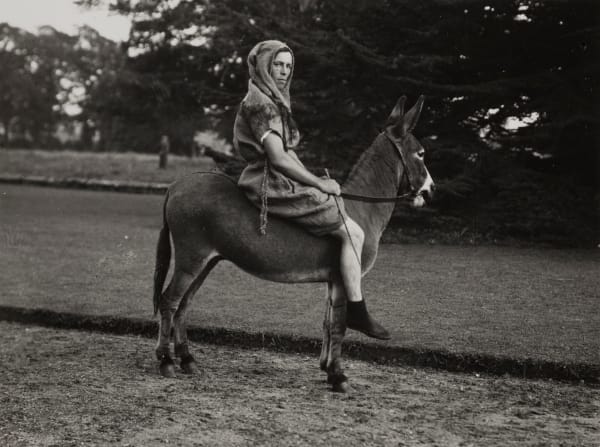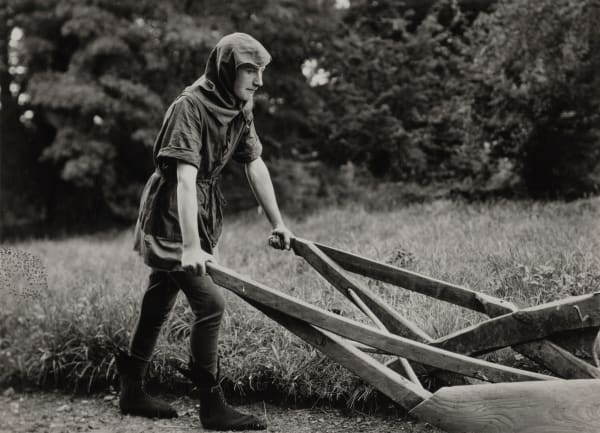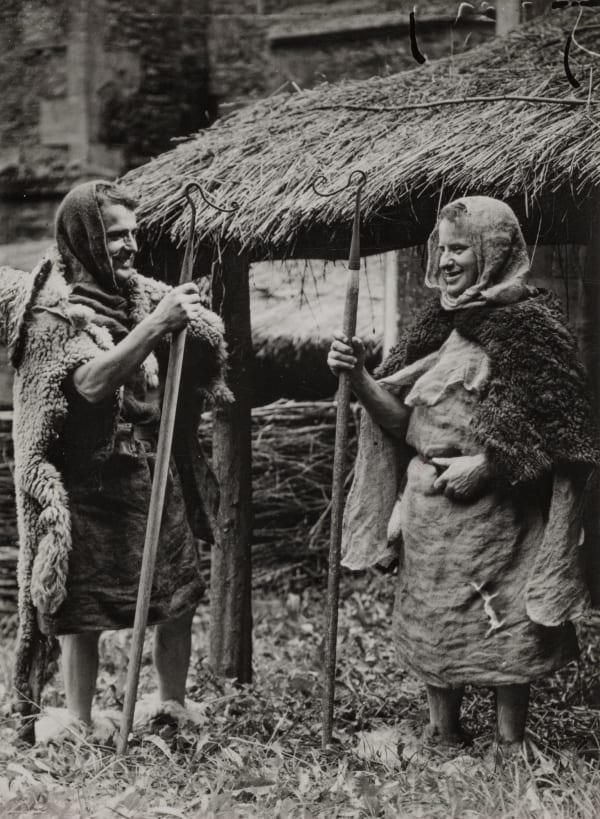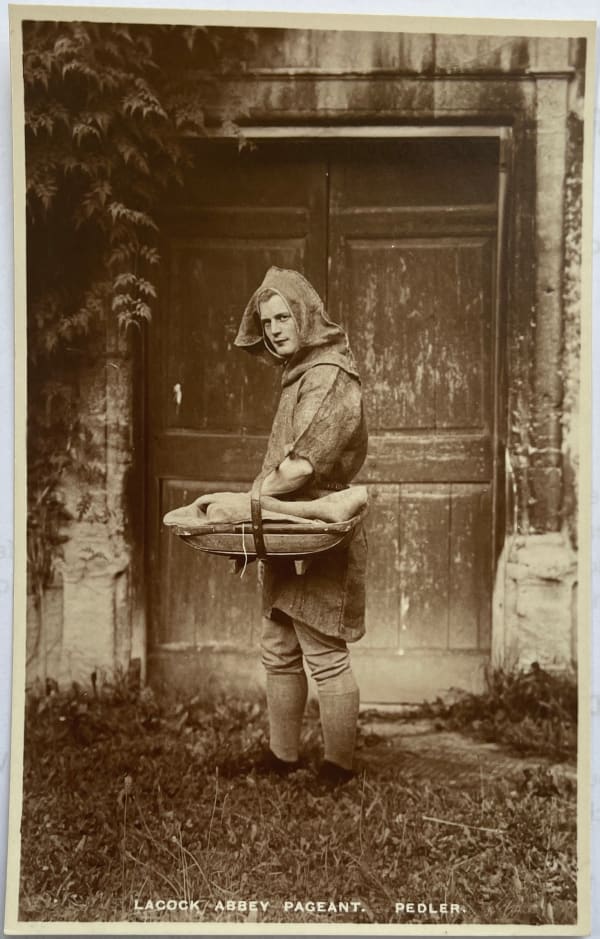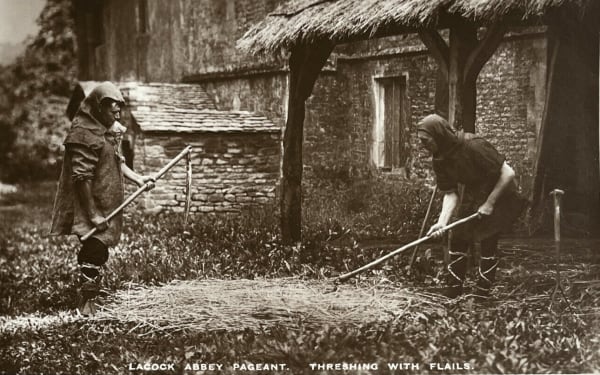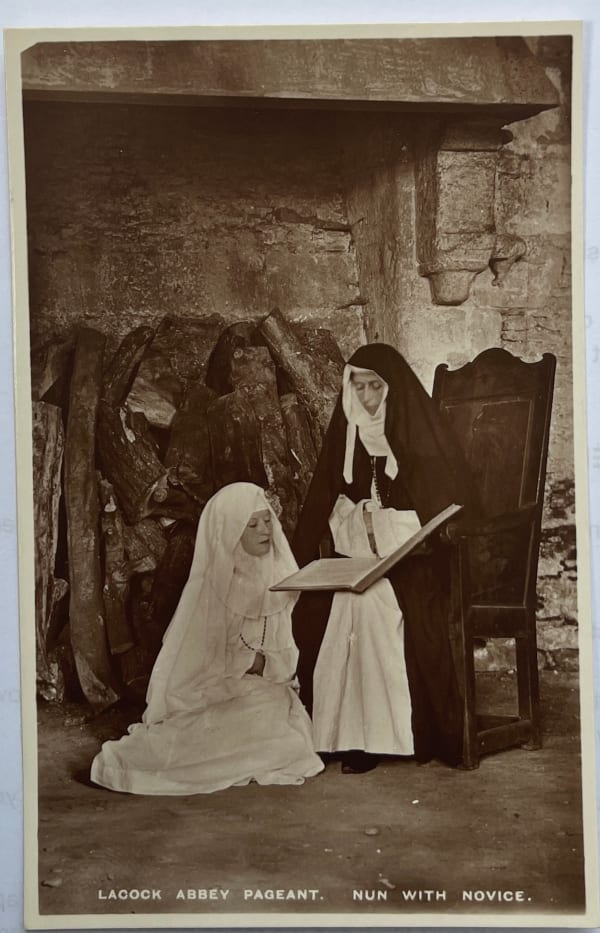One of E. O. Hoppé's more extraordinary projects was to record the pageant at Lacock Abbey in 1932. Reflecting the national craze from Edwardian times for local pageants celebrating the past, the Lacock Abbey Pageant shows the resilience of these village pageants during the inter-war period. In this case the pageant commemorated the 700th anniversary of the founding of Lacock Abbey and was also a celebration of local crafts.
The Hyman Collection contains the only known prints of these works and has acquired all twenty one photographs of the pageant that were in the E. O. Hoppé Estate Collection.
Graham Howe who runs the Hoppé Estate Collection has pointed out that Hoppé's photographs of the Lacock Pageant recall those of his friend Sir Benjamin Stone, who likewise recorded local folk traditions and customs. They also anticipate the quirkiness of Tony Ray-Jones' depiction of the English in the 1960s, the peculiarity of Homer Sykes' project on local customs, Once A Year, of the early 1970s, and the community spirit of Anna Fox's series Back to the Village that depicts events in the village of Selborne since 1999.
Lacock Abbey was the ancestoral home of William Henry Fox Talbot and the idea of a pageant appears to have been the idea of Miss Matilda, or ‘T.’, Talbot, Countess of Salisbury, who seems to have planned and organised the pageant. In one letter, Talbot wrote of her conception: ‘Our main concern is the 13th century background of all the village activities and pastimes, and costume with correct implements. This background is to continue throughout the evening, after the episode closes.’
In her autobiography Matilda Talbot references Hoppé's admiration for "the spirit of dedication" of the participants; writes of the ideas behind the pageant; and stresses the importance of depicting the trade and professional activities of the village as well as the more formal pageant. She writes that they decided that all of those involved should belong to the village or be their friends, and that "everybody should be shown engaged in his own trade, the blacksmith should be the blacksmith, the shepherd a shepherd, and so forth." Matilda Talbot, My Life and Lacock Abbey, pp.220-227.
The Pageant commemorated the founding or ‘Hallowing’ of the Abbey by Lady Ela, Countess of Salisbury (Talbot’s ancestor), the role of whom was played by Talbot at the Pageant. Ela founded the Abbey as a memorial to her husband William Longespée, a natural son of Henry II and a founder of Salisbury Cathedral.
The day consisted of a ceremonial part with Bishop and Clergy commemorating the founding of the abbey as well as a re-enactment of 'a typical day in the thirteenth century'. Hoppé appears to have focused on the latter aspect. This included medieval crafts and foods including brewing, fishery, agriculture, blacksmithing (on a replica 13th century forge) and weaving. The Bath Chronicle praised the bakery: ‘An exactly similar bakery exists in Lacock today and therefore many of the people of that place eat bread which is based on precisely the same principles.’ Another commentator in the paper noted: ‘Here lies the genius of organisation and the proof of the real hard work of the players—the pageant did not merely portray, but actually was that fete day in the life of Lacock, 1232.' (source: historicalpageants.ac.uk )
Hoppé's photographs of Lacock Abbey Pageant do not appear to have ever been published in periodical or book form. However, an invoice from the Dorien Leigh agency to Talbot reveals that the photographs were commissioned by her to be made into postcards, several of which are also in the Hyman Collection:
Miss M. T. Talbot,
Laycock Abbey,
Chippenham, Wilts
DORIEN LEIGH
CAMERA STUDIES IN HOME SURROUNDINGS
August 26th 1932
Professional visit of photographer to Lacock Abbey as arranged.
500 postcards of one subject
250 postcards of each of 26 subjects
100 postcards each of 18 subjects
1203 additional postcards.
Please note that actually 1215 additional postcards have been sent, but from this number perhaps you would be good enough to select 12 to make up the full complement of the Stilt-Walkers of which only 238 were made.
The invoice does not mention Hoppé by name but the postcards are creditted to the agency Dorien Leigh, which he had founded in 1916. By 1932 he was actively developing its activities, and each of the Lacock Abbey Pageant images have Hoppé negative number on the back and can be traced back to his negative log books.
We are grateful to Graham Howe at the Hoppé Estate Collection and Michael Pritchard at the Royal Photographic Society for their assistance in cataloguing these works. For more detailed information on the pageant, and images of more of the postcards, see also Brian Howells Banks, Lacock Medieval Pageant 1932, Hobnob Press, 2007.
 Emil Otto Hoppé, Bear and Handler. Mr R Vines (handler), Mr E Vines (bear) (Lacock Abbey Pageant, Wiltshire), 1932View more details
Emil Otto Hoppé, Bear and Handler. Mr R Vines (handler), Mr E Vines (bear) (Lacock Abbey Pageant, Wiltshire), 1932View more details Emil Otto Hoppé, Bear and Handler. Mr R Vines (handler), Mr E Vines (bear) (Lacock Abbey Pageant, Wiltshire), 1932View more details
Emil Otto Hoppé, Bear and Handler. Mr R Vines (handler), Mr E Vines (bear) (Lacock Abbey Pageant, Wiltshire), 1932View more details Emil Otto Hoppé, Chess Players. Dr Lowe (right) and friend (Lacock Abbey Pageant, Wiltshire), 1932View more details
Emil Otto Hoppé, Chess Players. Dr Lowe (right) and friend (Lacock Abbey Pageant, Wiltshire), 1932View more details Emil Otto Hoppé, Constable. Mr Bird arresting Mr Martin (Lacock Abbey Pageant, Wiltshire), 1932View more details
Emil Otto Hoppé, Constable. Mr Bird arresting Mr Martin (Lacock Abbey Pageant, Wiltshire), 1932View more details Emil Otto Hoppé, Dairymaids. Mrs Pocock, Mrs RIng (Lacock Abbey Pageant, Wiltshire), 1932View more details
Emil Otto Hoppé, Dairymaids. Mrs Pocock, Mrs RIng (Lacock Abbey Pageant, Wiltshire), 1932View more details Emil Otto Hoppé, Dining Party. Mr Richard Foley (centre), Mr P.F. Hodgson (Lacock Abbey Pageant, Wiltshire), 1932View more details
Emil Otto Hoppé, Dining Party. Mr Richard Foley (centre), Mr P.F. Hodgson (Lacock Abbey Pageant, Wiltshire), 1932View more details Emil Otto Hoppé, Draught Players (Lacock Abbey Pageant, Wiltshire), 1932View more details
Emil Otto Hoppé, Draught Players (Lacock Abbey Pageant, Wiltshire), 1932View more details Emil Otto Hoppe, Ela, The Countess of Salisbury - Miss Matilda Talbot (Lacock Abbey Pageant, Wiltshire), 1932View more details
Emil Otto Hoppe, Ela, The Countess of Salisbury - Miss Matilda Talbot (Lacock Abbey Pageant, Wiltshire), 1932View more details Emil Otto Hoppé, Goat Girl. An abbey friend (Lacock Abbey Pageant, Wiltshire), 1932View more details
Emil Otto Hoppé, Goat Girl. An abbey friend (Lacock Abbey Pageant, Wiltshire), 1932View more details Emil Otto Hoppé, Man and Donkey (Lacock Abbey Pageant, Wiltshire), 1932View more details
Emil Otto Hoppé, Man and Donkey (Lacock Abbey Pageant, Wiltshire), 1932View more details Emil Otto Hoppé, Masons. Waler Banks, T. E. Gerrish (Lacock Abbey Pageant, Wiltshire), 1932View more details
Emil Otto Hoppé, Masons. Waler Banks, T. E. Gerrish (Lacock Abbey Pageant, Wiltshire), 1932View more details Emil Otto Hoppé, Miller. Mr Tanner (left), Mr Marks (Lacock Abbey Pageant, Wiltshire), 1932View more details
Emil Otto Hoppé, Miller. Mr Tanner (left), Mr Marks (Lacock Abbey Pageant, Wiltshire), 1932View more details Emil Otto Hoppé, Ploughman. Mr Philip Pocock (Lacock Abbey Pageant, Wiltshire), 1932View more details
Emil Otto Hoppé, Ploughman. Mr Philip Pocock (Lacock Abbey Pageant, Wiltshire), 1932View more details Emil Otto Hoppé, Shepherds. R Self (left) (Lacock Abbey Pageant, Wiltshire), 1932View more details
Emil Otto Hoppé, Shepherds. R Self (left) (Lacock Abbey Pageant, Wiltshire), 1932View more details Emil Otto Hoppé, Swineherd. Hopkins' son (Lacock Abbey Pageant, Wiltshire), 1932View more details
Emil Otto Hoppé, Swineherd. Hopkins' son (Lacock Abbey Pageant, Wiltshire), 1932View more details Emil Otto Hoppé, Tithing Man (Lacock Abbey Pageant, Wiltshire), 1932View more details
Emil Otto Hoppé, Tithing Man (Lacock Abbey Pageant, Wiltshire), 1932View more details Emil Otto Hoppé, Tithing Man and Girl (Lacock Abbey Pageant, Wiltshire), 1932View more details
Emil Otto Hoppé, Tithing Man and Girl (Lacock Abbey Pageant, Wiltshire), 1932View more details Emil Otto Hoppé, Ale Wives. Mrs Taylor, Mr Marks, Mrs Tanner (Lacock Abbey Pageant, Wiltshire), 1932View more details
Emil Otto Hoppé, Ale Wives. Mrs Taylor, Mr Marks, Mrs Tanner (Lacock Abbey Pageant, Wiltshire), 1932View more details Emil Otto Hoppé, Pedler (Lacock Abbey Pageant, Wiltshire), 1932View more details
Emil Otto Hoppé, Pedler (Lacock Abbey Pageant, Wiltshire), 1932View more details Emil Otto Hoppé, Pedler. Postcard (Lacock Abbey Pageant), 1932View more details
Emil Otto Hoppé, Pedler. Postcard (Lacock Abbey Pageant), 1932View more details Emil Otto Hoppé, Smithy. Mr Jack Ring (Lacock Abbey Pageant, Wiltshire), 1932View more details
Emil Otto Hoppé, Smithy. Mr Jack Ring (Lacock Abbey Pageant, Wiltshire), 1932View more details Emil Otto Hoppé, Smithy. Postcard (Lacock Abbey Pageant), 1932View more details
Emil Otto Hoppé, Smithy. Postcard (Lacock Abbey Pageant), 1932View more details Emil Otto Hoppé, Stilt Walkers. Mr Vines (left) (Lacock Abbey Pageant, Wiltshire), 1932View more details
Emil Otto Hoppé, Stilt Walkers. Mr Vines (left) (Lacock Abbey Pageant, Wiltshire), 1932View more details Emil Otto Hoppé, Stilt Walkers. Postcard (Lacock Abbey Pageant), 1932View more details
Emil Otto Hoppé, Stilt Walkers. Postcard (Lacock Abbey Pageant), 1932View more details Emil Otto Hoppé, Threshing with Flails. Postcard (Lacock Abbey Pageant), 1932View more details
Emil Otto Hoppé, Threshing with Flails. Postcard (Lacock Abbey Pageant), 1932View more details Emil Otto Hoppé, Cooks Postcard (Lacock Abbey Pageant), 1932View more details
Emil Otto Hoppé, Cooks Postcard (Lacock Abbey Pageant), 1932View more details Emil Otto Hoppé, Goose Girl. Postcard (Lacock Abbey Pageant), 1932View more details
Emil Otto Hoppé, Goose Girl. Postcard (Lacock Abbey Pageant), 1932View more details Emil Otto Hoppé, Goose Girl. Postcard (Lacock Abbey Pageant), 1932View more details
Emil Otto Hoppé, Goose Girl. Postcard (Lacock Abbey Pageant), 1932View more details Emil Otto Hoppé, Nun with Novice. Postcard (Lacock Abbey Pageant), 1932View more details
Emil Otto Hoppé, Nun with Novice. Postcard (Lacock Abbey Pageant), 1932View more details